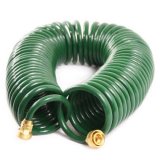|
Planting Asparagus
Plant asparagus in early spring, after
the soil has warmed up to about 50 degrees F. There is no
advantage to planting the crowns earlier in cold, wet soils.
They will not grow until the soil warms and there is danger of
the plants being more susceptible to disease if crowns are
exposed to cold, wet soils over a prolonged period.
Plant the asparagus where it will
not shade the other vegetables and will not be injured when the
rest of the garden is tilled.
You can start asparagus from seed,
but germination is slow (four weeks or more), and weeds are
difficult to control in young seedlings. Plants grown from seed
indoors can be transplanted -the following
spring -to a permanent location .
It is more advisable to start from
"crowns" . Choose large, one-year-old crowns if possible.
They transplant easier, produce plants as vigorous as
two-year-old crowns and are less expensive.
Site Selection is critical for asparagus . Select an area
that is free of perennial weeds . Asparagus prefers a loamy soil that is
well drained. If possible start to prepare a site 1 year in advance of
planting by turning the soil and adding
compost. Check your soil pH ,
and be sure there is plenty of well rotted organic matter present.
Space asparagus crowns 12 inches to 18
inches apart in the row. When you want more than one row, space
rows 4 feet to 6 feet apart.
Traditionally, crowns are planted in a deep trench or furrow.
Recent research shows no benefit from planting crowns deeper
than 4 inches to 6 inches in the trench. Spread out the fleshy
roots at the bottom of the furrow. Lightly cover the crown with
soil. Gradually fill in the furrow as shoots emerge. Never
completely bury the developing asparagus fern.
Do not compact the soil over the newly
filled furrow or the emergence of the asparagus will be
severely reduced. Spears should emerge within one week in moist
soils.
By mid-season of the planting year, a ridge forms that is 4
inches to 6 inches high and 2 feet wide over the asparagus
crowns. Maintain this ridge for the duration of the planting.
To plant asparagus, dig a trench 6-8
inches deep , wide enough to spread out the roots of the crown
in the trench bottom.
Place the crown in the bottom of the
trench - buds upward. Cover the crowns with 2 inches
of soil. As the plants grown, additional soil should be added to
the trench until it is completely filled at the end of the first
season. Deep planting will allow for easier cultivation without
injury to the plants.
Watering
Moisture during the summer is critical to keep the plants healthy
because next year's crop is directly related to health of the fern
growth after the spears have been harvested in the present year.
Asparagus is very drought tolerant and will generally survive without
supplemental watering. It seeks moisture deep in the soil. However, if
rainfall is insufficient when planting or afterwards, it is beneficial
to irrigate the crowns. Otherwise the plants will become stressed and
growth will be impeded.
The incidence of disease can be reduced by proper spacing and by
watering early in the day so leaves dry quickly or by using soaker
hoses. Inexpensive Water timer systems are available .
are available . |
 
Self Coiling Hoses
|
| |
Weed
control
Control weeds by hand-pulling or shallow cultivation to avoid injury to
the plant roots.
In
a small planting, it's more practical to control weeds through
shallow cultivation by hoeing. Using an organic mulch such as grass
clippings that have not been treated with a herbicide also helps control
weeds. . If perennial grasses and broadleaf weeds have gotten out of
control, use glyphosate (Roundup) before spears emerge in the spring.
During harvest keep cultivation shallow to prevent damaging the spears
that have emerged. Organic mulches may be used to inhibit weeds
Common table salt once was used to control weeds in
asparagus. But is no longer recommended. Although asparagus is
more tolerant of high salt levels in the soil than most plants, the
sodium in table salt can permanently destroy the soil structure.
Fertilizer
Fertilize annually . Immediately after harvest apply about 2 pounds of a
5-10-10 fertilizer per 100 square feet , or spread well rotted
manure, or Liquid Fish Concentrate over the bed. You
may add additional well-rotted manure or compost in late fall.
Lime and fertilizer
applications are best based on a
soil test. In general,
two pounds each of actual nitrogen, phosphorus (P2O5), and
potash (K2O) per 1,000 square feet of garden space is
adequate
See
Gurney's Asparagus Food Fertilizer which is formulated specifically for Asparagus.
which is formulated specifically for Asparagus.
|